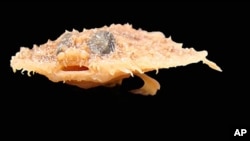The International Institute for Species Exploration has released its Top 10 List of New Species for 2011 and many on the list are already threatened or endangered. Institute head Quentin Wheeler says the new discoveries highlight how little scientists know about life on Earth.
The Institute’s planet-wide new species include an iron-oxide eating microbe that was discovered forming icicle-shaped “rusticles” on the legendary shipwreck, the Titanic. There’s also a two-meter-long fruit-eating lizard from the Philippines; a cricket that pollinates a rare orchid in the Mascarene Archipelago in the Indian Ocean; a jumping cockroach from South Africa and two very distinct fungi.
“The mushroom that is bio-luminescent around the clock that showed up in the Atlantic coastal forests in Brazil," says Wheeler. "And certainly the mushroom that was fruiting under water is just a startling new biological discovery.”
Also on the list: a spider from Madagascar whose durable webs can span rivers, streams and lakes; a leech from Peru with gigantic teeth and a bottom-dwelling pancake fish in the Gulf of Mexico which resembles a walking bat.
Wheeler says the largest species on the list is an antelope that was first discovered being sold as bush meat in a West African market. “(That’s) kind of frightening because by all indications, it is a pretty rare species, otherwise it would have been described before now.”
Wheeler adds that he’s also alarmed that many of the newly described species are simultaneously threatened or endangered or occupy particular habitats around the world that are under stress.
About two million species have been named, described and classified since the early 18th century, when a system was devised to categorize all known varieties of plants and animals. But as many as 100 million more are waiting to be discovered, according to Wheeler, who believes knowing all the elements of the earth’s ecosystems is critical to our survival.
“Unless we know what species exist to begin with, we’re fairly powerless to detect and monitor changes in that biodiversity, even if they were increases, rather than decreases," he says. "We simply don’t know what is there to begin with.”
Wheeler says each species is a piece of Earth’s history so they must be documented.
“Evolution has been carrying on trial and error experiments for 3.8 billion years and has confronted many of the same problems that humanity is facing now," he says. "So if we simply learn species and learn how they have evolved in response to various challenges, we can just get incredible ideas for design and engineering and inspiration for other kinds of problem solving.”
Wheeler says on average scientists discover and describe between 15,000 and 20,000 new species a year, a process he wants to accelerate with new Internet-based-tools. He hopes the Top 10 New Species list helps to raise public awareness of the rich, diverse, planet we inhabit.










